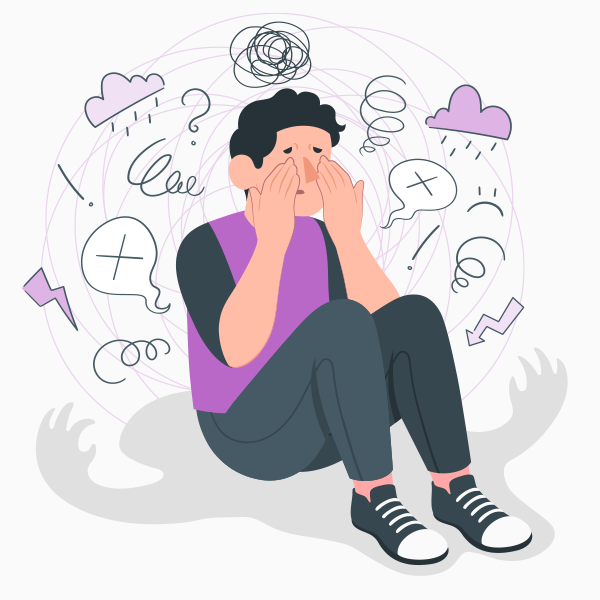Generalized Anxiety Disorder (GAD) represents an amplified response to perceived stress or threats. While anxiety is a common human emotion experienced sporadically, GAD intensifies this response, leading to persistent and excessive feelings of unease. Discover more about this prevalent mental health condition.
Anxiety becomes a disorder when it becomes excessive, persistent and interfere with daily life. Anxiety disorders are a group of conditions, related to mental health, characterized by prolonged and very intense feelings of apprehension, worry and fear. This condition can significantly impact a person’s behaviors, thoughts and emotions. In today’s demanding world, it’s common for individuals to experience anxiety, for people with generalized anxiety disorder (GAD), anxiety is a persistent and overwhelming presence in their lives. GAD is a common form of anxiety that is characterized by uncontrollable worrying about different aspects of life, usually without specific cause or reason.

Other forms of anxiety disorders:
- Panic disorder
- Social anxiety disorder (SAD)
- Specific phobias
- Obsessive compulsive disorder (OCD)
- Post traumatic stress disorder (PTSD)
Generalized Anxiety Disorder (GAD)
GAD is one of the most common anxiety disorders. Excessive and persistent concern or anxiety over different aspects of life, such as job, health, family, and daily tasks, characterizes it. Individuals with GAD typically find it difficult to regulate their fears, and they may feel chronic anxiety that lasts for at least six months or longer, as normal worry, which is transitory and unique to certain situations. A case study was conducted for GAD on an adult.

Some of the most common features and symptoms of GAD are:
1. Excessive Worry
People with GAD usually experience excessive and uncontrollable worry about a lot of concerns, related to daily life and tasks. They frequently predict disaster or catastrophic results, even when there is no obvious cause for concern.
2. Restlessness and Irritability
GAD often manifests as restlessness, being easily tired and fatigued or feeling on edge. Irritability over many things and difficulty concentrating are some of the common symptoms related to GAD.
3. Physical Symptoms
People who have GAD, may experience some physical symptoms as well, including headache, stomachaches, trembling, difficulty sleeping, muscle tension and sweating.
4. Overthinking and Indecisiveness
People with GAD, tend to overthink and usually have difficulty making decisions. They constantly need reassuring, and after every decision, they second guess themselves.
Causes and Risk Factors of Generalized Anxiety Disorder (GAD)
GAD is a condition that usually begins from a combination of genetic, psychological and environmental factors. Researchers are still trying to find the exact cause of GAD, which is not fully understood. They have identifies many of the potential contributors. Here are some of the key factors to consider:
1. Genetic Predisposition
Genetics plays a key role in GAD. People with a family history of disorders related to anxiety, including GAD, maybe at a high risk of developing the condition. Certain inherited traits and genetic variations can affect the brain’s response to stress and leads to the development of anxiety disorders.
2. Brain Chemistry Imbalance
Our body is rich in neurotransmitters, which are the chemicals that facilitate communication between brain cells. Any form of imbalance in neurotransmitters, such as dopamine, gamma aminobutyric acid (GABA), serotonin, leads to anxiety disorders. Any change in the functioning of these neurotransmitters can affect the regulation of our emotions and feelings, leading to heightened anxiety.
3. Environmental Factors
Many environmental factors can lead to the development of GAD. Prolonged stress exposure, such as catastrophic events, abuse, or chronic life pressures, might raise the likelihood of developing anxiety disorders. Adverse childhood experiences or a chaotic home setting may also have an influence on the development of GAD later in life.
4. Cognitive Factors
Individual’s vulnerability to GAD might be influenced by how they perceive and interpret their surroundings. Negative thought patterns, excessive worrying, and a tendency to interpret circumstances as threatening or harmful can all contribute to the emergence and persistence of anxiety disorders. Individuals with perfectionistic inclinations or a need for control may also be more prone to GAD symptoms.
5. Personality Traits
Many of the personality traits have been linked with an increased risk of the development of GAD. People who are highly sensitive, usually have a low level of tolerance for uncertainties, or are prone to excessive worrying and overthinking may be more susceptible to develop GAD. People with a history of shyness or social anxiety may be at a high risk of experiencing GAD symptoms.
6. Medical Conditions
Medical conditions such as cardiovascular diseases, chronic pain or thyroid disorders can co occur with GAD or can contribute to an increase in the risk of developing anxiety symptoms.
Treatment Strategies of Generalized Anxiety Disorder (GAD)
GAD treatment often consists of a combination of counselling, medication, and self-help measures. Cognitive-behavioral therapy (CBT) is a popular therapeutic method that assists individuals in identifying and changing problematic thinking patterns as well as developing appropriate coping mechanisms. A healthcare provider may prescribe medications such as selective serotonin re-uptake inhibitors (SSRIs) or benzodiazepines to treat symptoms.
Self-care measures such as stress management, regular exercise, yoga, relaxation exercises, and keeping a healthy lifestyle can also help with GAD management. Seeking emotional support and understanding from loved ones, as well as joining support organizations, can help.
If you or someone you know is suffering GAD symptoms, it is critical to seek the advice of a mental health professional in order to receive an accurate diagnosis and suitable treatment. Individuals with GAD can effectively manage their symptoms and enhance their overall well-being with the correct assistance and therapies.
The Bottom Line
Generalized Anxiety Disorder is a real and treatable condition that affects many individuals worldwide. By understanding its causes, recognizing the symptoms, and implementing effective coping strategies, those living with GAD can regain control over their lives. If you or someone you know is experiencing symptoms of GAD, remember that seeking professional help and building a support network are essential steps towards finding relief and living a fulfilling life despite the challenges posed by the disorder.
Recommended Read: Yoga for Stress Relief and Better Health: 6 Poses to Help You Find Balance




